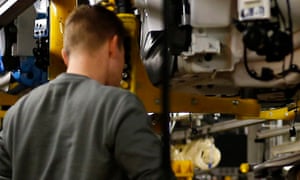UK manufacturing sector registers worst performance in years
Factories suffered decline in growth of domestic orders in February coupled with a second month of falling exports

Britain’s factories suffered a decline in growth of domestic orders in February which, coupled with a second month of falling exports, saw them register their worst performance in almost three years.
The weakening picture, which also saw a second month of declining employment, comes after George Osborne warned of a cocktail of threats andgathering storm clouds in the world economy wreaking havoc on global trade.
The Markit/CIPS purchasing manager’s index (PMI) posted its lowest reading since April 2013 – the first month of the current 35-month sequence of expansion – at 50.8 in February, down from 52.9 in January, where a figure above 50 indicates expansion.
Rob Dobson, a senior economist at Markit, described the UK’s manufacturing sector as in a state of “near stagnation” after the ongoing difficulties faced by exporters were mirrored in the domestic market.
“The breadth of the slowdown is especially worrisome. The domestic market is showing signs of weakening while export business continued to fall.
“A lot of this is driven by the ongoing weakness of global commodity prices. However, there are also signs that weaker growth is driving up competition between manufacturers to secure new business and among their suppliers too.”
He added that an expected interest rate rise by the Bank of England was disappearing over the horizon, saying: “The near stagnation of manufacturing highlights the ongoing fragility of the economic recovery at the start of the year and provides further cover for the Bank of England’s increasingly dovish stance.”
The collapse in the UK’s steel industry appears to have filtered out to other areas of industrial production, which slumped to a seventh-month low.
A recent fall in the pound is expected to offer manufacturers a helping hand, though Dobson said the likely increase in import costs over the coming months “will be unwelcome to manufacturers, especially given the imminent introduction of the new national living wage”.
David Noble, the chief executive of CIPS, said it was worrying that manufacturers had reduced their input stocks for the fourth month in a row “in anticipation of a slowing growth rate and poor demand”.
Scott Bowman, UK economist at Capital Economics, was more upbeat. He said: “While this survey shows the near-term prospects for manufacturing remain poor, the recent fall in the pound will provide some welcome relief for manufacturers in time.
“What’s more, we expect global growth will pick up slightly in 2016, so manufacturing prospects should improve as the year progresses. However, the effect that the EU referendum vote has on the exchange rate and demand from Europe adds to the uncertainties facing the sector.”
Figures from Markit also showed the eurozone’s manufacturing sector expanded at a slower rate in February, fuelling fears its economy is heading into trouble. The latest PMI reports showed output growth was at its lowest level for a year after hitting 51.2, down from 52.3 in January. France and Germany were to blame after both hovered near to stagnation.
The only boost to confidence came from employment figures that showed the unemployment rate across the eurozone hit its lowest level since August 2011, the early months of the debt crisis.
The eurozone jobless rate dropped slightly to 10.3% in January, from 10.4% in December, for the first time since August 2011. That continues a slow recovery since April 2013, when the euro area unemployment rate hit 12.3%, though in Greece and Spain about one in four continue to be out of work. In the wider EU, the jobless rate dropped to 8.9% from 9% – the lowest in more than six years.
[Source:- Thr Gurdian]

